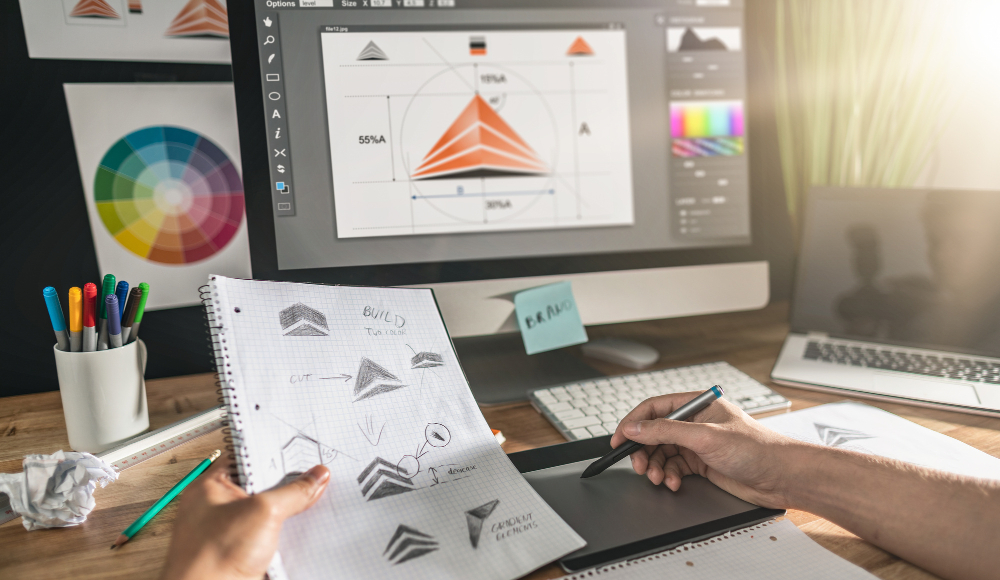Line25 is reader supported. At no cost to you a commission from sponsors may be earned when a purchase is made via links on the site. Learn more
In the digital marketplace, where your virtual storefront isn’t just a point of sale but the embodiment of your brand identity, the importance of a compelling, memorable logo cannot be overstated.
Your logo isn’t merely a decorative element. It’s the visual keystone of your brand, a symbol that – in an instant – conveys the essence of who you are, what you stand for, and what customers can expect when they engage with your business.
For the inspiration and understanding needed to design an eCommerce logo, let’s start with the best practices:
eCommerce Logo Design Best Practices

In this comprehensive guide, we’ll delve deep into the art and science of effective methods in creating a custom logo for your business, highlighting best practices and illuminating examples to help you navigate this crucial aspect of your branding strategy.
1. Simplicity
In a world cluttered with information, simplicity stands out. It’s tempting to create a logo that’s complex and detailed, but in reality, the most recognizable logos in the world are simple. They don’t make your eye dart from corner to corner trying to take in all the details. Instead, they offer something effortless to identify and remember, which is essential in the fast-scrolling world of online shopping and vital for link building techniques in boosting business visibility.
For instance, think of the iconic Apple logo. It’s a straightforward, bitten apple that has become synonymous with the brand’s ethos of simplicity and sleek, user-friendly design. This approach is particularly vital for an e-commerce logo. Your logo will appear in various contexts—your website, social media platforms, packaging, advertisements, and more. A simple logo maintains its integrity and is recognizable at a glance, regardless of where it’s displayed.
Other examples of effective simple e-commerce logos include eBay’s lowercase fonts and colorful letters, IKEA’s blue and yellow wordmark, and Target’s unambiguous bullseye.
2. Scalability
Your e-commerce logo will need to fit everywhere—from a tiny icon on a smartphone screen to the large format of a billboard or poster. It’s crucial to design a logo that’s legible and impactful, no matter its size.
Consider the logo of e-commerce giant Amazon. The simple, lowercase ‘amazon’ with a smiley arrow from ‘a’ to ‘z’ is identifiable even when it’s the size of a postage stamp. It doesn’t lose its effectiveness when scaled because it’s a clean, uncomplicated design with a clear message—it sells everything from ‘a’ to ‘z’, and it does so with customer satisfaction at its heart.
The Nike ‘Swoosh’ is another great example of scalability. Whether it’s embroidered on a hat or flashing on an LED screen, the iconic checkmark symbol maintains its power.
3. Relevance
Your logo should be a visual summary of your brand’s soul. What are your core values? What products do you offer? Who is your target audience? The imagery, colors, and fonts you choose should be informed by these questions.
For an e-commerce business specializing in vintage clothing, a logo incorporating retro fonts and classic fashion iconography (such as a hat, dress, or sewing machine) would instantly communicate the nature of the products.
In contrast, a tech e-shop might opt for modern, sans-serif fonts and imagery that reflects innovation, like a lightning bolt or an abstract, futuristic symbol. Online retailer Newegg makes this apparent through its stylized ‘N’ logo that looks like an electrical circuit.
4. Distinctiveness
In the sea of e-commerce sites, what will make yours stand out? Your unique value proposition should be evident in your logo. Don’t be afraid to take risks and differ from the norm, but keep in mind that uniqueness shouldn’t come at the expense of clarity or relevance.
A great example is the logo for Etsy, a global e-commerce website focused on handmade or vintage items and craft supplies. Its cursive, slightly imperfect logo reflects its commitment to craftsmanship, community, and the uniqueness of its offerings. This logo tells a story about the brand—it’s not just a forgettable mark.
Online grocer Thrive Market took a daring approach with an abstract logo comprised of geometric shapes in shades of green. This creative branding instantly aligns them with health and sustainable living.
5. Color Psychology
Colors are a powerful communication tool because they convey emotions and experiences. While selecting your logo’s colors, consider the psychology behind them.
Blue, for instance, exudes trust and professionalism. That’s why Facebook chose a blue ‘F’ icon and Amazon sports a blue smiley arrow. Green often represents tranquility and health, and is commonly used for eco-friendly or organic products, like Grove Collaborative’s green leaf logo. Red is exciting and bold, often used to compel viewers to action—think of a SALE sign.
An excellent example is an e-commerce business selling sustainable products as an example. A logo with natural colors like greens and earth tones, perhaps even integrating nature-based symbols, will instantly communicate the brand’s commitment to the environment and sustainable living.
6. Typography Talks
The font you choose speaks volumes. Serif fonts can convey elegance and tradition, while sans-serif fonts usually have a more modern, clean look. Script fonts can be perceived as personal and creative, but they need to be used carefully to maintain legibility.
For a platform selling luxury watches or jewelry, a serif font like Cartier uses might imply sophistication and a timeless quality, appropriate for high-end products.
Conversely, an e-commerce platform offering modern art or tech gadgets might lean towards a clean, minimalist sans-serif to maintain a contemporary, sleek feel. Electronics retailer Newegg does this well.
7. Versatility
Your logo should be like a chameleon: able to fit in seamlessly, regardless of its surroundings. This means it must look good in different formats, in full color or black and white, and both online and off.
The key is to avoid designing a logo that relies heavily on color to make an impact, as it might lose its effectiveness when photocopied or faxed.
An excellent example of versatility is the Nike “Swoosh.” It’s recognizable in any color and on any medium—from a shoe to a billboard, to an app icon. It’s a simple, fluid design that’s instantly identifiable, whether it’s on a paper tag or a flashing digital ad.
8. Timelessness
In the rapidly evolving realm of e-commerce, what’s trendy today may be outdated tomorrow. Avoiding gimmicks or overly trendy elements ensures your logo won’t seem dated after a few short years.
The iconic Coca-Cola script logo has remained relatively unchanged since its creation in 1887, making it one of the most recognizable logos across generations. Its flowing, classic script evokes a sense of American nostalgia.
The Disney logo has also largely remained the same for decades. Its whimsical, characteristic script font is a staple of its brand identity, immediately conjuring images of fantasy, storytelling, and family-friendly entertainment. Despite the evolution of the company and its many branches, the central logo remains timeless, easily adapting to various themes and properties.
9. Legal Protection
Once you’ve invested time and money into creating your logo, you’ll want to protect it legally. Registering for a trademark safeguards your logo from infringement and imitation.
The process involves filing an application with the U.S. Patent and Trademark Office and demonstrating your logo is distinctive enough to warrant protection. While not mandatory, trademark registration provides important legal benefits and exclusive rights to your logo.
10. Technical Considerations
To implement your logo properly across platforms, keep these technical factors in mind:
- File Format: EPS and vector PDFs are ideal for scalability. JPG, PNG work for digital use.
- Color Mode: RGB is best for digital use, CMYK for print materials.
- Sizing: Create responsive logo sizing guidelines for use on website, merch, ads, etc.
- Clear Space And Minimum Size: Define spacing and minimum size to retain legibility.
These technical specifications will come into play when your logo appears on your website, apparel, print ads, product packaging, and more.
11. Seek Feedback And Redesign Accordingly
The design process shouldn’t end once your logo mark is complete. Seek ongoing feedback from customers and branding experts and tweak your logo as your business evolves.
As your company grows, you may find opportunities to refine, simplify, or modernize your logo. While your logo should feel familiar, periodic updates can keep it feeling fresh and relevant. Just be sure to retain brand recognition as you evolve your logo.
In Conclusion
Crafting an impactful e-commerce logo requires balancing creative vision and strategic design, but the reward is immense: a distinctive visual beacon guiding your brand’s journey. With simplicity, scalability, and timelessness as guiding principles, let your logo encapsulate your essence and resonate with your audience.
Though the process takes effort, an effective logo marks a bold, memorable start, building brand recognition and emotional connection. Let it steer your e-commerce voyage towards new horizons.

